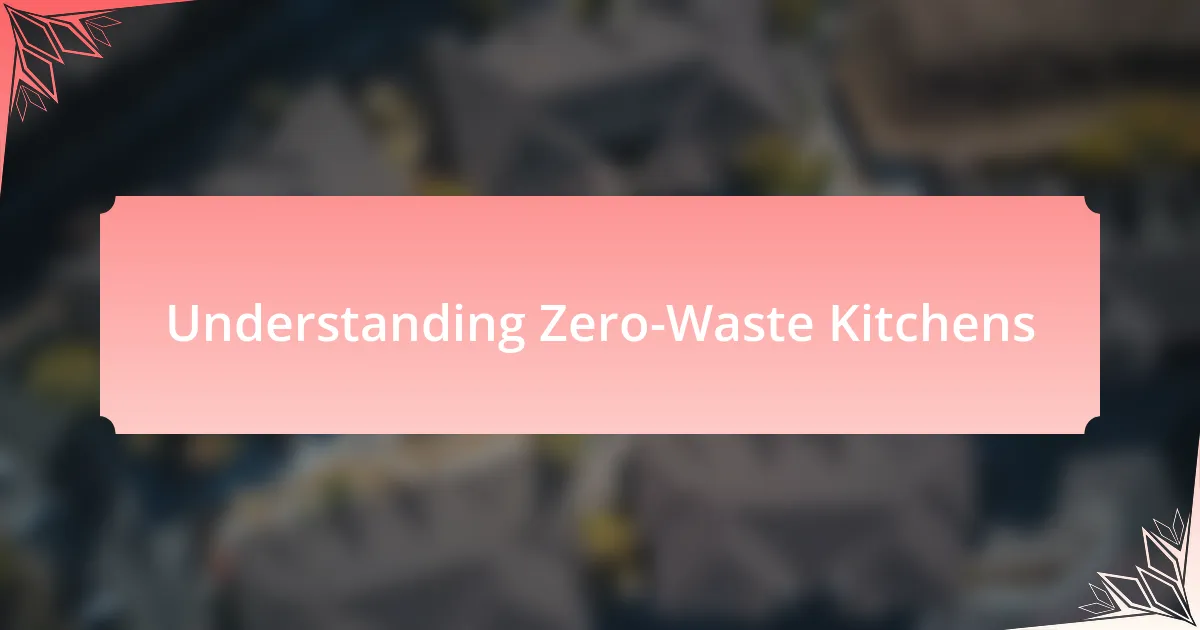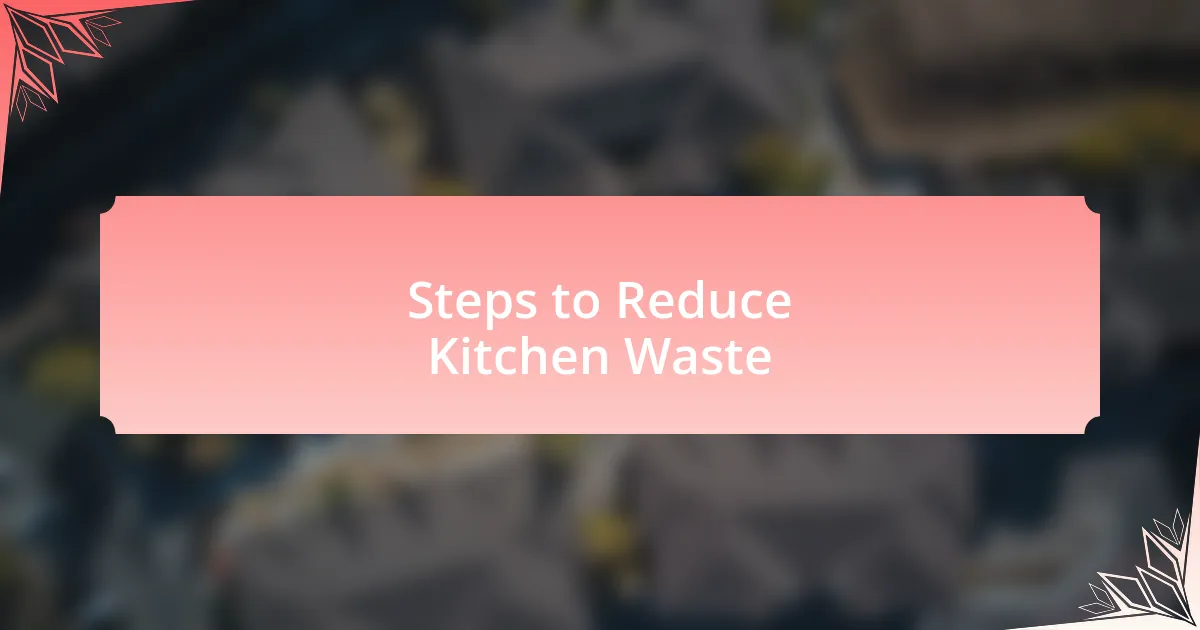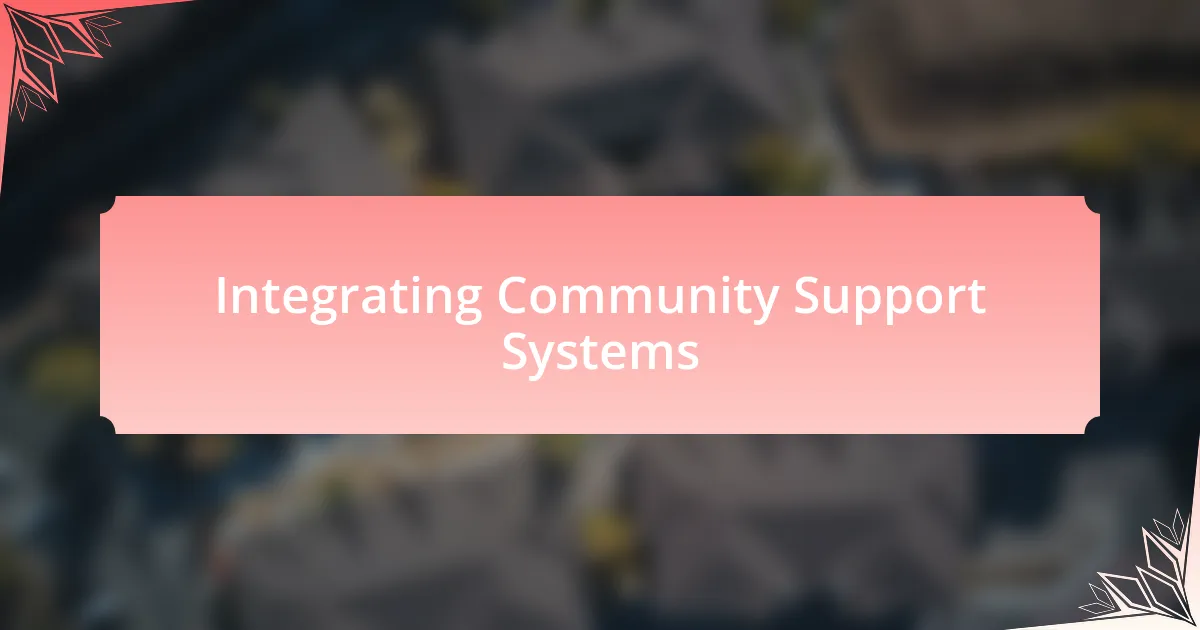Key takeaways:
- Zero-waste kitchens focus on minimizing waste through mindful changes, like meal planning and using reusable materials, leading to a more sustainable lifestyle.
- Community engagement, such as attending local workshops and participating in produce swaps, strengthens commitment to sustainability and creates a supportive environment.
- Starting small, embracing mistakes, and building a support network are crucial for a successful transition to zero-waste practices, making the process manageable and rewarding.

Understanding Zero-Waste Kitchens
A zero-waste kitchen revolves around the idea of minimizing waste generated from food and packaging. In my journey, I found that simple changes, like using cloth bags instead of plastic ones for groceries, made a significant impact. Have you ever considered how small choices can lead to a larger shift in your lifestyle?
The emotional satisfaction of reducing waste is truly rewarding. I remember the first time I realized there was almost no trash in my kitchen after a week of focused effort. It felt liberating—almost like achieving a personal milestone. Isn’t it fulfilling to know that our efforts contribute to a healthier planet?
Implementing a zero-waste approach isn’t just about recycling; it’s about rethinking our habits. One day, as I was chopping vegetables, I suddenly stopped to save the scraps for homemade broth instead of tossing them away. This shift made me wonder how many other opportunities we overlook in our daily routines. How often do we see waste as an inevitable part of cooking, when it can actually be transformed into something useful?

Importance of Sustainable Living
Sustainable living is essential because it allows us to make conscious decisions that positively impact our environment. When I began my own journey, I realized how interconnected our lives are with the planet. For instance, choosing seasonal produce not only supports local farmers but also reduces the carbon footprint associated with transporting food long distances. Have you ever thought about how much your food travels before it reaches your table?
The beauty of sustainable living is in its ripple effect. I once hosted a potluck dinner where everyone brought a dish prepared with minimal waste—reusing glass jars, composting leftovers, and sharing tips on sustainable practices. It sparked conversations about the choices we make and how they influence our community. How can we inspire one another to adopt similar habits?
Moreover, embracing sustainability fosters a deeper appreciation for our resources. I vividly recall the moment I switched to composting. Watching kitchen scraps transform into rich soil felt like a natural cycle that I was part of. It made me reflect on how waste isn’t just trash; it’s potential. Isn’t it empowering to recognize that we have the ability to turn our waste into something beneficial for ourselves and the earth?

Steps to Reduce Kitchen Waste
One effective step I took to reduce kitchen waste was meal planning. Initially, I felt overwhelmed, but once I started, it became exciting to think creatively about using what I already had. This not only minimized food scraps but also saved me time and money. Have you ever tried planning your meals for the week? It can really shift your relationship with food.
Another practice I adopted was using glass containers for food storage. Not only do they keep food fresher, but they can be reused countless times, which drastically cuts down on single-use plastics. I remember the satisfaction I felt when I organized my pantry and replaced all those disposable bags with stylish glass jars. It transformed my kitchen into a space that felt intentional and waste-conscious. Isn’t it uplifting to see how a small change can lead to a more organized and sustainable kitchen?
Lastly, I made a conscious effort to compost. The first time I filled my compost bin, I could hardly believe how much organic waste I had previously thrown away. It was liberating to know that my scraps were contributing to a healthier environment rather than just filling a landfill. Have you ever considered what happens to your food scraps? Taking that additional step connects us more closely to the very nature of food and its lifecycle. It feels like reclaiming a part of our responsibility toward the planet.

Integrating Community Support Systems
As I integrated community support systems into my zero-waste kitchen journey, I discovered the invaluable role of local resources. Attending community workshops on sustainable living not only equipped me with practical skills but also connected me with like-minded individuals. Have you ever experienced that thrill of sharing knowledge and ideas with others who share your passion? I found that brainstorming with fellow community members brought a fresh perspective to my practices, amplifying my commitment to sustainability.
One memorable experience was joining a local swap event where neighbors exchanged surplus produce and homemade goods. Seeing the community come together to reduce waste was inspiring. It was here that I realized how much we can achieve collectively; one person’s surplus can become another’s staple. It’s amazing to think about the connections we forge through these simple acts, isn’t it? By fostering an environment of sharing and support, we can create a culture that prioritizes waste reduction and sustainability.
Additionally, I reached out to local businesses to support my zero-waste goals. Establishing relationships with nearby farmers and zero-waste shops not only helped me source bulk goods but also reinforced my sense of community. I recall the warmth I felt when my local grocer offered me reusable bags instead of single-use packaging. It’s these little moments of connection that remind us how integral our communities are in the journey towards a sustainable lifestyle. How has your community supported your own eco-friendly initiatives?

Tips for a Successful Transition
Transitioning to a zero-waste kitchen can feel overwhelming at first, but starting small makes the journey manageable. I began by replacing one single-use item at a time — my first victory was swapping paper towels for reusable cloths. It was such a satisfying moment when I realized how easy it was to adopt a more sustainable habit without drastic lifestyle changes. Have you ever felt that sense of accomplishment in tackling a goal step by step?
Another valuable tip is to embrace the learning curve. I vividly remember my initial attempts at composting, which resulted in a few messy mistakes! However, each mishap taught me something new and reinforced my commitment to reducing waste. Isn’t it interesting how those little challenges can turn into powerful learning experiences? By allowing ourselves the freedom to make mistakes, we create space for growth and innovation.
Finally, don’t underestimate the power of a supportive network. I set up a group chat with friends who were all exploring zero-waste practices. Sharing our successes — and occasionally our struggles — opened up conversations and solutions I might not have considered. Have you thought about how sharing can enhance your journey? I’ve found that exchanging tips and encouragement not only motivates us but turns the transition into a shared adventure rather than an isolated task.